CompTIA's Generational Research on Technology and its Impact in the Workplace focuses on how technology impacts generational issues. The objectives of this research include:
The study consists of four sections, which can be viewed independently or together as chapters of a comprehensive report.
Section 1: Education Market Background, Technology Attitudes and Priorities
Section 2: Education Technology Usage and Adoption
Section 3: Education Technology Practices, Demand Drivers and Obstacles
Section 4: Education Technology Satisfaction
Levels
To view other sections of this report please go to the research page on the CompTIA website.
The data for this study was collected via a quantitative online survey conducted May 9 to May 17, 2013 to a sample of 700 respondents who work in an office environment with some form of technology. The sample was segmented to include respondents from different age groups/generational cohorts from a variety of industry sectors. .
The margin of sampling error at 95% confidence for aggregate results is +/- 3.8 percentage points. Sampling error is larger for subgroups of the data. As with any survey, sampling error is only one source of possible error. While non-sampling error cannot be accurately calculated, precautionary steps were taken in all phases of the survey design, collection and processing of the data to minimize its influence.
CompTIA is responsible for all content contained in this series. Any questions regarding the study should be directed to CompTIA Market Research staff at research@comptia.org.
CompTIA is a member of the Marketing Research Association (MRA) and adheres to the MRA's Code of Market Research Ethics and Standards.
Today's workforce is undergoing a seismic shift in generational makeup, a change in basic composition that imposes serious management implications for corporations now facing an employee base whose ages span a huge chasm — in many cases 40 years or more.
The facts are clear: A large portion of workers from the Baby Boomer generation (those over 50 years old), long the dominant segment of the U.S. workforce, are now screeching toward retirement. Most will be replaced by far younger workers from Generation Y, also known as Millenials (20-34 years old). Wedged in the middle is Generation X (35-49 years old), which finds itself in a peculiar position.
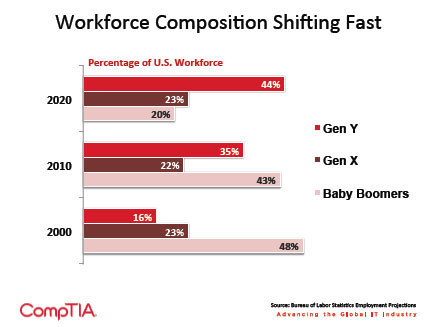 Due to its relatively small population numbers, Gen X will never be the predominant age bracket in the labor force; Gen Y will be. Leapfrogging this
middle generation upends the natural progression of workforce composition. The youngest segment of workers in the labor market are expected to be the most voluminous by roughly 2015, according to the U.S. Bureau of Labor Statistics projections.
Due to its relatively small population numbers, Gen X will never be the predominant age bracket in the labor force; Gen Y will be. Leapfrogging this
middle generation upends the natural progression of workforce composition. The youngest segment of workers in the labor market are expected to be the most voluminous by roughly 2015, according to the U.S. Bureau of Labor Statistics projections.
It hasn't happened yet, of course. Gen Y has come of age during a dismal job market, with many unable to land a position after graduating from college. In fact, the unemployment rate still stood at 13.2% among 20-to-24-year-olds in May, compared to just 5.3% for workers 55 and older, according to the Bureau of Labor Statistics. But as the upper tier of Baby Boomers drops from the workforce and the economy stabilizes or improves, younger workers will be filling the job ranks rapidly alongside Gen X and the remaining Baby Boomers, many of whom are continuing to work beyond the "conventional" retirement age of the early- to mid-60s.
What does the generational switcheroo mean for employers? Consider a few "fun" facts below about Gen Y, the Millenial cohort that will soon represent the bulk of the IJ.S. workforce. These tidbits reveal a different set of expectations, work preferences and attitudes that younger employees bring to the workforce — and that business owners will need to accommodate.

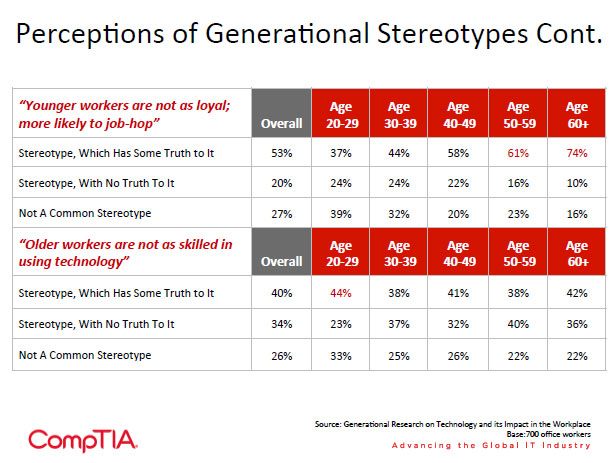 For companies, managing across many age groups is no small feat when you consider these differences in skill sets, work habits, employer
loyalty and preferences for the type of IT tools they use. External market factors are also in play to generate a workplace in flux; the rapid pace of technological change, new ways information is shared and stored in the cloud, the advent of social
media, the embrace of telecommunting and BYOD.
For companies, managing across many age groups is no small feat when you consider these differences in skill sets, work habits, employer
loyalty and preferences for the type of IT tools they use. External market factors are also in play to generate a workplace in flux; the rapid pace of technological change, new ways information is shared and stored in the cloud, the advent of social
media, the embrace of telecommunting and BYOD.
Another important factor to consider beyond age is job role within an organization. Often what position a person holds — senior executive vs. staff level or IT manager vs. marketing VP — dictates work habits, priorities and attitudes more so than which generation an individual hails from.

In order to understand various differences and commonalities among generations of workers, it's important to note the way they engage with technology in the workplace. Technologies viewed as mind-blowing by one generation maybe viewed as old news by others. The few examples in the chart below highlight just how fast the technological landscape has changed from generation to generation.

When asked to assess their employer, workers gave relatively high marks in the area of technology utilization. Roughly half described their employer as either "cutting edge" or in the "upper tier" in use of IT, while slightly less (42%) put their companies somewhere in the middle of the adoption curve. Just 11% placed their employer on the low side of tech savvy and use.
That said, younger workers were more likely than older to identify their company as on the ball when it comes to technology at work. Six in 10 Gen Y workers gave their employer net positive ratings, compared with just 31% of Baby Boomers. One might posit from that difference that Baby Boomers place less emphasis on technology in general, therefore not gleaning an accurate picture of where their employer stands. Indeed, the data finds that this population is less inclined to rate an institution's tech-savvy as a high-priority in deciding to choose to accept a job.
How individual workers choose to rate their own tech abilities — vs their employer's bleeds along generational lines, as the chart below indicates:
In terms of device usage, the study finds relative ubiquity across all generations of workers with regard to the mainstays of the workplace such as desktops, which 79% have used in the past year; printers, which 74% have used and laptops, which 64% have used. usage differences do emerge across generations, job roles and gender when talking about devices that fall into the "newer" categories. Tablets, smart phones, digital cameras and GPS devices fall into this bucket.
Consider just a few examples: With regard to using a smart phone for work purposes in the last 12 months, 74% of Gen Y workers said they did compared with 37% of Baby Boomers. Workers in their 30s, 40s and 50s were also slightly more likely than the youngest workers to use a landline telephone and/or a standard cell phone for work in the last year. In fact, just 6% of 20-something employees conducted business on a standard cell phone, illustrating just how pervasive and essential the smartphone — be it an iPhone, Android or other — has become to youth.
Job role is also a driving factor in the adoption of "newer" hardware and communications tools as the nearby chart details.
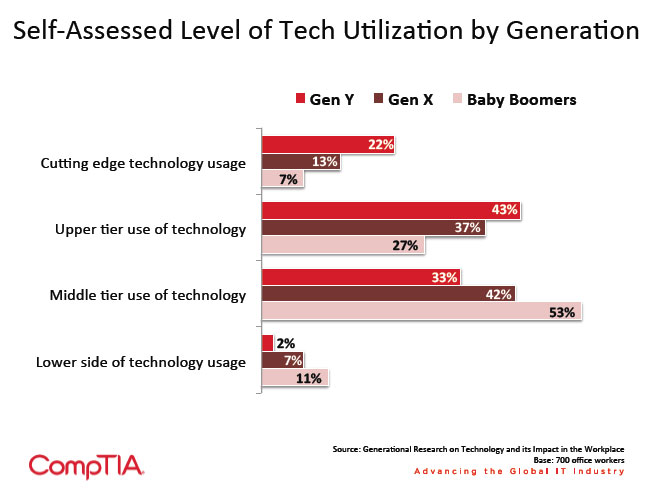
Interestingly, there were significant gender differences with the use of technologies such as tablets, smart phones, GPS and even laptops. Males were far more likely in many cases than females to have used any of these devices in the course of their work life in the past year. Consider the following:
 A few possibilities exist for the gender gap. Generally speaking, males across all age categories are more likely than females to self-identify as "cutting edge" or "upper
tier" in their use of technology. It's also an established fact — at least at present that significantly more males work in the IT industry itself, which, compared with other industries such as manufacturing, tends to enjoy more widespread adoption
of the latest and greatest IT tools, along with a high degree of familiarity and skill among its workers.
A few possibilities exist for the gender gap. Generally speaking, males across all age categories are more likely than females to self-identify as "cutting edge" or "upper
tier" in their use of technology. It's also an established fact — at least at present that significantly more males work in the IT industry itself, which, compared with other industries such as manufacturing, tends to enjoy more widespread adoption
of the latest and greatest IT tools, along with a high degree of familiarity and skill among its workers.
The greatest parity between the sexes for device usage comes among Gen Y and Baby Boomers. Younger and older females tended to use devices in closer to equal fashion last year for work as men in these two generational brackets.
An area where stark differences are seen across age groups and generations is in the incidence of using a personal device or application for work purposes — in tech-speak known as BYOD or BYOA. Taken in the aggregate, there's a near-even split of all workers that incorporate personal tech into work and those that do not. Looking more closely at the the demographic breakdowns, however, and it's abundantly clear that this practice is far more prevalent, and presumably valued, by younger workers.
Nearly two thirds of Gen Y workers use a personal device or application at work compared with just a third of Baby Boomers. Six in 10 workers in the 20- and 30-something range used a personal device or application for work, while the percentage who did declined from that point with each rising decade in age.
With regard to software, Microsoft Office applications — particularly Microsoft Word — remain a juggernaut in today's workplace. Nearly 9 in 10 workers used Word in the last year, another 7 in 10 are on the Excel bandwagon and half created presentations or charts in PowerPoint. These percentages hold across every decade of worker, from 20- to 60-somethings. The lone exception among the three Office applications in question, Powerpoint, saw greater usage among 20- and 30-somethings by double or more than older workers.
That said, younger workers were twice as likely to have used an alternative word processing or productivity application, such as Google Docs or Zoho, in the last year than those in the 40 and up slice, which could indicate more experience and familiarity with SaaS-based programs in the cloud among the younger demographic. And yet, despite this willingness to branch out, close to half of these same younger workers (Gen X and Gen Y) said they expect their use of Microsoft Office to increase in the next several years. That compares with 3 in 10 50-somethings expecting an increase. In all, just 9% of workers believe Office usage will decline in any notable degree in the coming years, which goes to show how entrenched Microsoft's bread-and-butter product suite is inside U.S. offices.

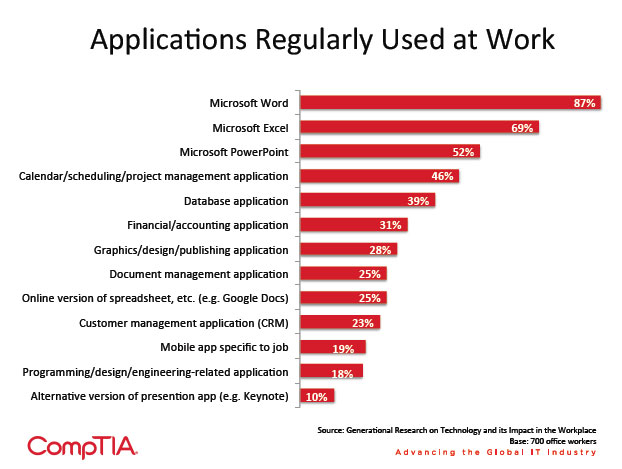
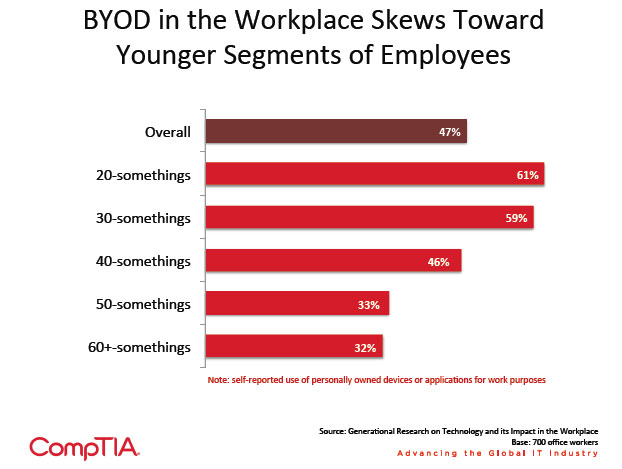
Ongoing education and training is an essential ingredient in today's workplace. Whether it's professional development in a worker's specific industry or discipline, course work toward certification or accreditation, or technical training that improves job efficiency, most workers typically undergo some form of skills training that furthers their career advancement potential. According to the American Society of Training and Development (ASTD), U.S. companies spent $156 billion on employee learning in 2011. Of this, about half ($87.5 billion) was spent internally, meaning training conducted by staff for staff.
Workers generally — age regardless — value training highly and cite more support for training, professional development and the opportunity to acquire new skills. This sentiment runs consistently across all three generations in this study. Career advancement opportunities ranked high in terms of improving job satisfaction as well and professional development training is an obvious conduit for that (see chart in Appendix). A net 6 in 10 workers said they would like to see more professional development and training offered to them in the future.
 Three quarters of the workers in the CompTIA study reported either participating in mandatory or voluntary training of some nature in the past 12 months.
A fourth indicated that they had taken part in no training at all. These percentages are consistent across all three of the generations examined (Gen Y, Gen X and Baby Boomer) although the youngest workers from Gen Y (20-somethings) participated in
voluntary training at a higher rate than any other age bracket. Three in 10 sought out training on their own, compared with an average of two in 10 across the other age groups.
Three quarters of the workers in the CompTIA study reported either participating in mandatory or voluntary training of some nature in the past 12 months.
A fourth indicated that they had taken part in no training at all. These percentages are consistent across all three of the generations examined (Gen Y, Gen X and Baby Boomer) although the youngest workers from Gen Y (20-somethings) participated in
voluntary training at a higher rate than any other age bracket. Three in 10 sought out training on their own, compared with an average of two in 10 across the other age groups.
One dynamic stands out with regard to the incidence of training: An apparent gender divide exists within Gen Y. Three in 10 young female workers reported participating in no training at all — neither voluntary or mandatory — in the past year, compared with just 17% of males in the same segment. The disparity is puzzling, especially given the youth factor and the fact that women today are graduating from college and entering the workforce in greater numbers than men. One possible explanation is that industries in which the two genders gravitate approach the requirement for training differently. For example, the IT industry, which places a high premium on technical training and the attainment of professional certifications, continues to possess a predominantly male workforce.
When asked, 34% of males said their employer has required them to attain a professional certification or credential of some type, while 24% of females answered similarly.
That said, a much higher percentage of Gen Y as a whole said their employer either required or encouraged them to attain a professional certification or credential. Just about every occupational field now has some type of certification or credential. Marketing, HR, research, sales, customer service, and of course, IT all have certifications and credentials to validate skills.
Among all workers in the study, roughly two-thirds do not currently hold any professional certification or credentials.
In terms of the types of training or professional development that workers have undergone in the last 12 months, the list is varied. Most prevalent is training that is specific to a worker's profession; for example a classroom-based session that trains an IT staffer on a vendor's latest product or technology. Not surprisingly, tech-related training is also high on the list. This can take two forms; training that is considered specific to the profession itself (e.g. the aforementioned example of the IT worker and new product training) or it can be basic training on the company's internal software applications, hardware devices and network dos-and-don'ts that is part and parcel of any new employee onboarding effort.
Other training types that workers participated include team-building/collaboration, sexual harassment, legal compliance and sales/business development. Not surprisingly, workers at mid-size and large companies reported the highest engagement in sexual harassment and legal -related training. Companies of this size are typically under federal mandates for training of this nature. Workers at the smallest firms (1-99 employees) reported the lowest incidence of training across most categories.
Tech training earned high praise; 7 in 10 workers saying it helps ensure they are not left behind at work.
Technology-related training as well social media use education were more prevalent among 20- and 30-something workers. Additionally, workers in senior executive positions were more likely than those in mid-level or staff positions to have taken part in tech-related and social media training.
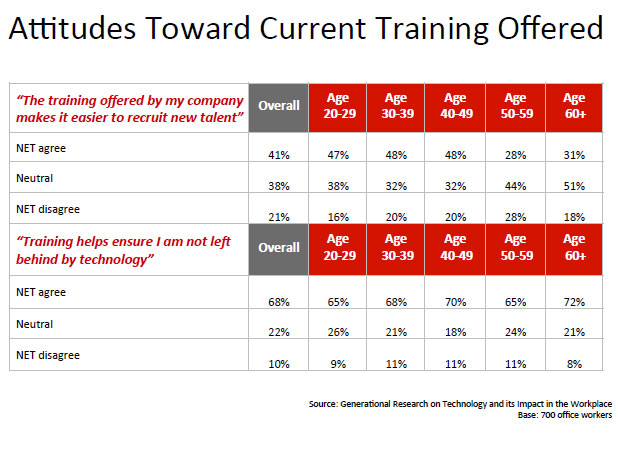
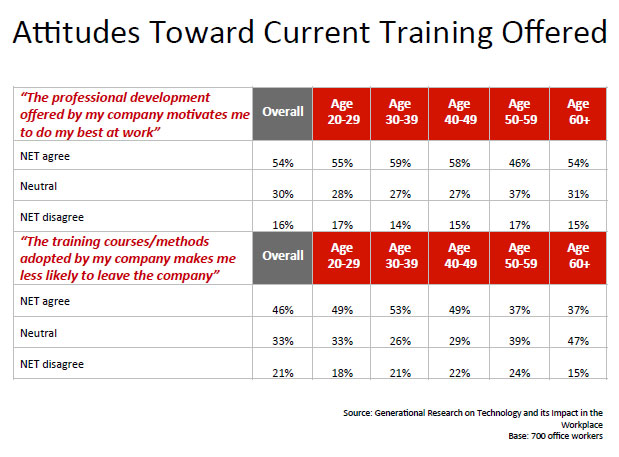
The Internet has changed how we work in innumerable ways, including the manner in which training and professional development take place. Whether enabling workers to pursue informal self-study online, review work manuals and other training guides virtually, or participate in full-on e-learning courses with or without an instructor, the Internet has broadened the number of options today's workforce has to develop new skills and grow in their careers.
Case in point: E-learning. Thirty-four percent of all respondents report that e-learning was a training methodology that they used in the past 12 months. E-learning tools and applications are being used for everything from human resources trainings about sexual harassment in the workplace to self-paced online work toward a professional credential. Not surprisingly, Gen Y workers availed themselves of e-learning in largest number, with 45% of them having used this method to train in the last year. E-learning is especially appealing to Gen Y workers, who tend to want to be autonomous in how they choose to interact with technology, deciding their own pace and not being forced to interrupt normal workflow to "take the training." E-learning allows the integration or flow of training to be done at a person's desk, woven in with regular work tasks and functions. This differs dramatically from taking time out to complete an in-person classroom training, for example.
Younger workers aren't the only ones seeing benefits from virtual learning. Nearly 4 in 10 Gen X and 35% of Baby Boomers went down this path for training in the last year.
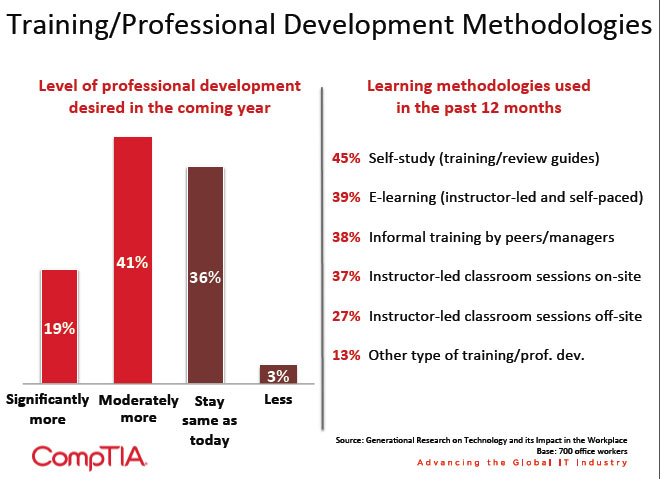
And yet despite the attraction behind e-learning, many of today's base-level training mechanisms remain conventional in nature, from informal education by peers and managers to instructor-led classroom sessions. Looking ahead, younger generations are increasingly interested in expanding how they receive training to include more progressive means such as social media elements, more mobility elements and simulations/gaming type constructs. Nearly half of workers in their 20s and 30s said the use of mobility- and social media as platforms for professional development and training would be beneficial. Likewise, more than a third of this group wants to train via simulation-type games that are increasingly popular interactive tools used for training of all types in business, from leadership training for executives and managers to technical skills training. By contrast, just 8% of Baby Boomers cited more gaming elements as a potentially useful resource.
Bottom line? The adage that every person learns differently is greatly amplified in the multi-generational workplace. And it's not just age brackets and generation timestamps. Job role matters too. For example, nearly twice as many senior staff (director or above) vs. mid- or staff level workers favor using social media, mobile solutions and gaming simulations for training and professional development.
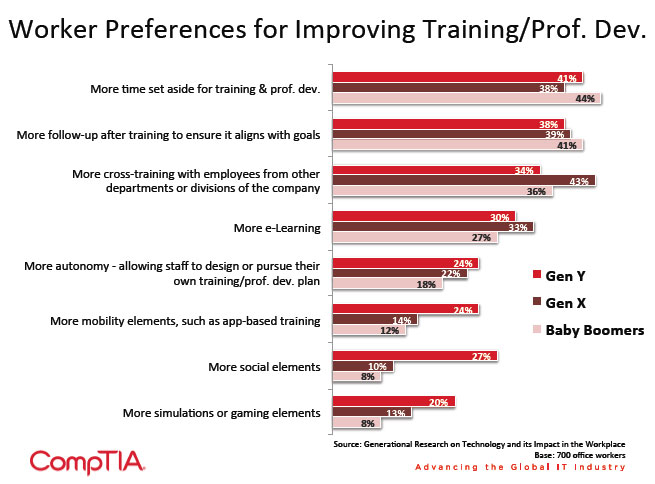
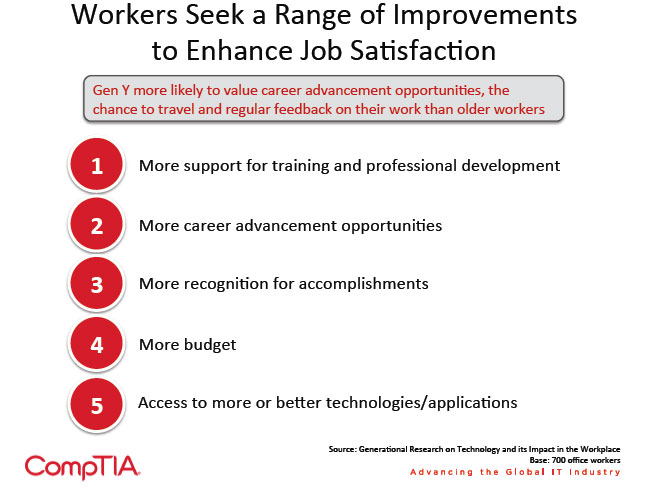
As noted previously, workers of all generations increasingly rely on a growing array of devices, applications and networks to perform their job. For many, this also comes with an "anytime, anywhere and any device" expectation.
While devices and applications continue to become more user-friendly, due to the influence of the consumerization of IT among other factors, the need for IT support remains a critical component of any user's experience. According to the data, most workers expect the need for IT support to increase or remain at the same level, with only a small minority expecting the need to decrease. undoubtedly, the types of devices and applications in need of support will evolve, but that will not diminish the presence of IT support itself.
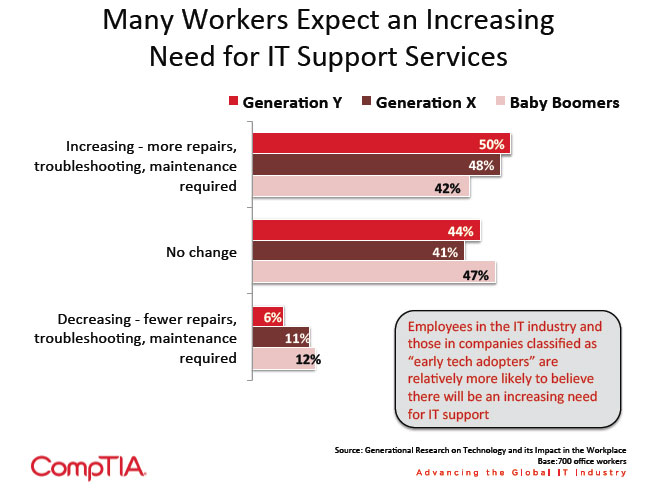
Additional Insights:
In any given 3-month time period, typically two-thirds of office workers will require some type of IT support. Assuming only one request per worker among u.S. companies, this translates to approximately 36.4 million IT support requests every three months.
While sales of PCs have likely peaked, their importance to office workers remains as vital as ever. Any issue with a desktop or laptop PC often means an abrupt halt to the workday. As such, according to CompTIA research, computers top the list of IT support ticket requests, with 47% of workers requiring troubleshooting or maintenance during the past three months.
In the minds of some, printers occupy a space similar to PCs — that is, a mature technology that will fade to obsolescence. And, like PCs, t's also a trend that is mostly overstated. Few workers can go completely paperless, which means most contend with printer support needs at least occasionally. In the CompTIA study, about 1 in 3 workers required some type of printer troubleshooting.
The next wave of support for many IT departments and IT support firms comes in the form of mobile devices. Smartphones and tablets are not necessarily new, but as these devices become more integrated into the enterprise, it's likely there will be new support requirements.

Overall, the data indicate that IT departments and IT support firms are doing a good job in meeting the support needs of their clientele. CompTIA's research finds that a net 3 out of 4 employees are satisfied with the current processes in place at their companies for repair, troubleshooting and maintenance of devices and applications. The one exception, employees in companies defined as 'late technology adopters' are relatively less satisfied with the processes at their firm, possibly a reflection of having fewer automated processes in place, such as help desk ticketing systems.
Despite the relatively high marks, room for improvement does exist. Given the fast-pace environments found in many companies today, it's not surprising that workers seek speedier turnaround when it comes to IT support. The Gen Y segment places a slightly higher premium on this area of improvement relatively to the other age segments.
All employees want to reduce the time it takes to resolve IT issues. Proactive maintenance to address issues before problems arise is one way to do that and is high on workers' priority list. This area of improvement rates especially high among the Gen X segment.
When properly explained to them, workers accept the fact that a few minor disruptions can accompany the routine IT maintenance that ultimately provides greater long-term up-time of devices and networks. For MSPs, this should be viewed as an affirmation of the managed services business model.
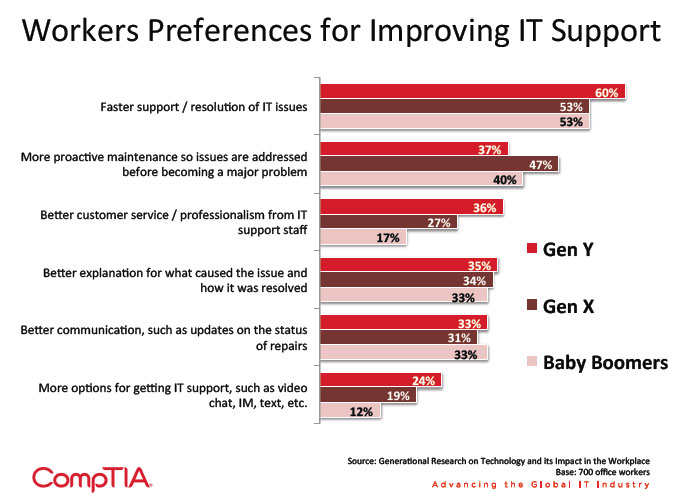
When IT issues do arise, workers engage in a number of practices to address the situation. The research confirms most workers attempt to fix the issue themselves. While this study did not go into detail on the specific nature of the IT support issues respondents faced, it can be assumed that most DIY IT support revovles around basic problems, such as re-mapping to a printer, installing updates or patches, or simply re-booting.
In some areas of IT support, generational differences emerge. The data suggests younger workers are slightly more likely to take a more proactive approach to resolving issues. As noted in Section 1 of this report, Gen Y tends to self-classify themselves as early technology adopters at higher rates than other age cohorts, which helps to explaing why they may be more likely to dig into IT problems on their own.
Interestingly, younger workers tend to feel a greater sense of responsibility when it comes to updating their devices; 1 in 5 twenty-somethings believe they should be the person to initiate the process. They do not see company policy playing much of a role in dictating when devices can — or should be upgraded. Across generations, around 4 in 10 employees want the IT department to initiate the process.
These findings point to the fact that employees look to their IT department to be a partner in the process of maintaining their devices. This allows IT departments the opportunity to engage with employees and educate them about relevant issues and help them make informed choices about their devices. CompTIA's research finds that younger workers are less likely to adhere to the company's IT policy when it comes to things like social media use. For them, the best way to secure an acceptance of policies might be to cultivate more of a partnership model between IT and younger staff.
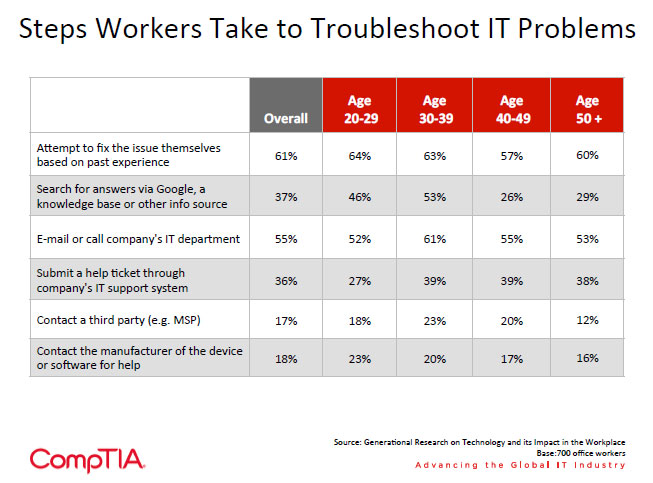
As expected, the incidence of automated IT support ticketing systems is highly correlated with company size. A small firm with 25 employees, for example, will not have the scale or scope of issues to warrant a system. In contrast, a large enterprise could never manage the volume and variety of IT support requests without a structured approach that leverages technology.
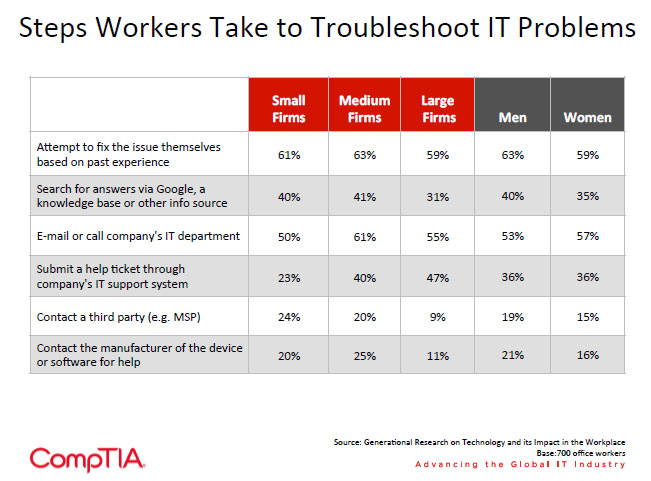
CompTIA's research finds that younger workers are more open to using a variety of emerging means to get the IT support they need. Instant messaging and the use of mobile apps to resolve IT issues are most popular. Similar to general trends in the customer service space, employees are also open to the idea of using social media for IT support that is related to repair, troubleshooting or maintenance of devices or applications.
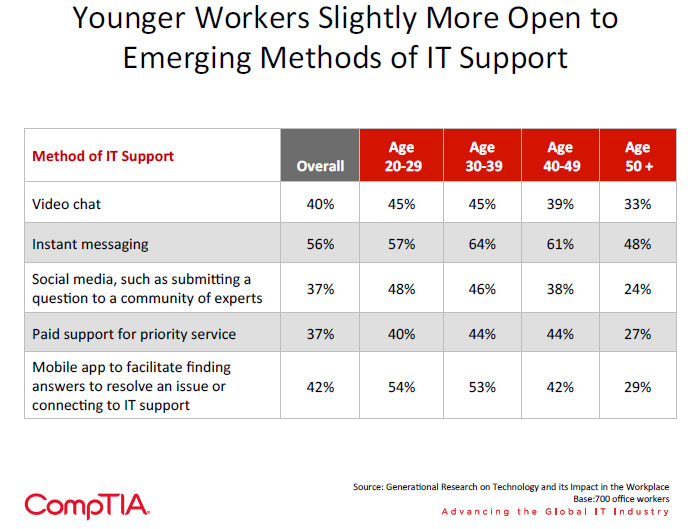
Moreover, 20- and 30-something workers look for more touch points for IT support such as video chat, or text.
Some employers are getting more creative in how they provide IT support to their workers; in large part they are looking to satisfy younger employees that are both heavily invested in their devices and applications and open to engaging with IT by myriad means. Consider companies such as Starbucks and software vendor SAP that have implemented a form of the help desk modeled on the Apple Store's Genius Bar. At the Starbucks Tech Café (that looks like the Apple retail store) employees can pick their equipment (their departments are billed for the same) and set up appointments to discuss tech issues or new software/hardware ideas for them to use on their jobs.
Employees in medium-sized companies are also more open to using more varied methods of support, while larger companies are likely to have established processes in place that restrict the avenues of support. Smaller companies might not have the infrastructure or the need for new methods of support. Employees in companies that are early adopters of technology are likely to have more exposure to new ways of doing things and are more open to using support methods such as video chat. Employees in the IT industry are also more open to using these support methods than other industries, which is not a surprising phenomenon given that the study finds workers in the IT industry in general operate at higher degrees of tech savvy and with deeper tech knowledge.
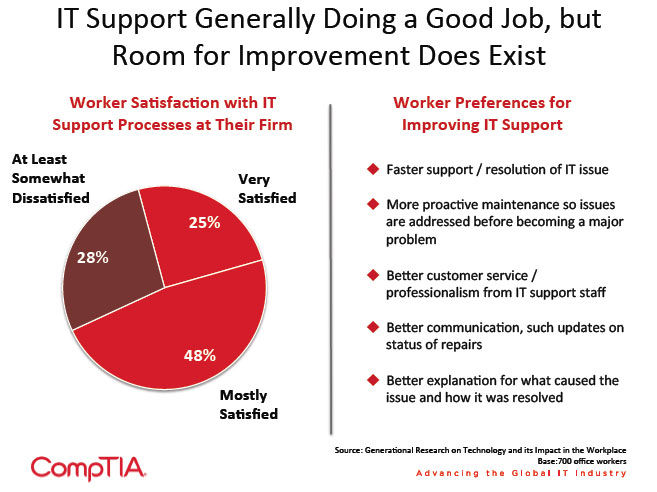
With employees of all ages routinely sharing today's workplaces, the existence of a "generational divide" is an unavoidable reality in many office situations. Take communication as a prime example. How workers of varying ages choose to collaborate with one another can expose a host of differences, from individual preferences for using various communications tools to attitudes about telecommuting and social media. Topics related to worker information-sharing will be explored in this report section.
Consider as a starting point, Internet access. Or more specifically, how critical it is to a worker's ability to function in the workplace. Quite critical, not surprisingly. CompTIA's study finds that nine in 10 workers said they would not be able to work as they normally do if there were an Internet outage.
And yet, if you peel back the onion a bit, the degree to which an Internet outage cripples an individual worker differs slightly based on age. CompTIA's study, along with other supporting research and anecdotal evidence, finds that a greater proportion of Baby Boomers (50+years) and Gen X (35-49 years) workers — though still a small percentage overall are able to function as they normally would with no access to the Internet. Eleven percent of respondents in these generational cohorts said they could function normally as opposed to only 5% in the Gen Y category (less than 35 years). Having grown up as 'digital natives' with technology as an extension of themselves, it is no surprise to find that 20-something workers are most inconvenienced by the lack of access.

The types of communications tools in the workplace have mushroomed in recent years far beyond the basics of landlines and email — although email remains the form of communication most prevalent, used nearly universally by respondents of all age categories in the course of their work duties. Texting, instant messaging and video conferencing are all showing fairly strong usage among office workers as well.
Generational differences are apparent with respect to newer forms of communication. For example, text and instant messaging are more commonly used for work purposes among individuals who are less than 50 years old. Likewise, confirming a popular stereotype, 20- and 30-something employees are much more likely to use social media such as Facebook for work-related purposes.
The propensity to use social media platforms for work purposes likely is attributable to more than just age brackets, however. Job role is also a determinant. Marketing departments, for example, have historically embraced social media as a tool for branding and promoting an organization regardless of the ages of the marketing executives. Meantime, many companies have begun to explore the potential opportunity to reach customers via social platforms; often this is a top-down exercise driven by executives inside a company. CompTIA's data shows that the majority of senior staff (53%) use Facebook for work and personal purposes as opposed to 21% of middle or staff level employees.

According to the research, Baby Boomer workers were less satisfied with the variety, quality and performance of communications tools at their company when compared to younger workers. The majority of workers across age groups believe that there is effective communication within their company but younger workers were more likely to be satisfied on this front. Gen Y and Gen X male employees are more satisfied with the variety, performance and effectiveness of communication tools when compared to female employees in these generational cohorts.
Across the board, workers are not concerned about new communication technologies causing an information overload. However, about a fifth of workers above the age of 50 have serious concerns that the use of mobile devices contributes to a decline in workplace/meeting etiquette. The preference of younger workers to communicate via blogs, text messages or instant messaging has led to some concern about the decline of face-to-face communications among older workers.
CompTIA's research confirms the prominent role social media plays in the life of younger workers. Nine out of 10 use Facebook and 39% of 20-something workers and 36% of 30-something workers use the social network for work and personal purposes. Just about one in five Baby Boomers use Facebook for both work and personal purposes. About a quarter of Baby Boomers do not use Facebook at all. The majority of respondents in larger companies (500+ workers) confine their use of Facebook for personal purposes —this is probably a function of larger companies restricting access as part of their IT policy. Employees of companies that are on the leading edge of technology adoption are more likely to use Facebook for work and personal purposes (38% as opposed to only 20% for companies defined as of Y skills middle or late technology adopters).
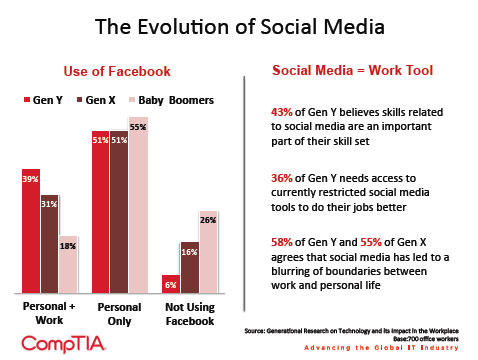
Twitter lags behind in use across all age groups and is primarily used for personal purposes. Gen Y workers are most at home with Twitter — just about a third do not use the platform as compared to the majority of Gen X (50%) and Baby Boomers (70%). Employees in companies defined as being early technology adopters are more likely to use Twitter for work and personal purposes. A third of employees in early technology adopter companies use the platform for work-related activities when compared to the less than 10% that use Twitter for work purposes in companies defined as middle or late adopters of technology. CompTIA's research finds that 20- or 30-something employees do not use LinkedIn as much as Facebook or Twitter.
Fifty-five percent of employees acknowledge that social media blurs the lines between work and personal lives). The majority of senior level employees (61%) take this viewpoint, most likely because they tend to use social media for both work and personal purposes in greater numbers than workers at staff level. That said, the majority of employees across age groups (64%) believe that social media adversely impacted productivity at work.
Employees in Gen Y and Gen X are more likely to agree with the statement that their social media savvy' is an important part of their skill set for work when compared to Baby Boomer employees. Younger workers see a greater connection between social media and their work and feel that their skills in this area are an important part of their value proposition.
CompTIA's research confirms that the younger generation looks at social media access as a given at work — 20-something workers are least likely to agree with restrictions and toe the company line when it comes to restricted social media use. Similarly, a third of Gen X employees (36%) feel that they currently don't have the access to certain social tools that they need to do their jobs effectively. Employees in larger companies are more likely to see the need for policies that might restrict social media use.
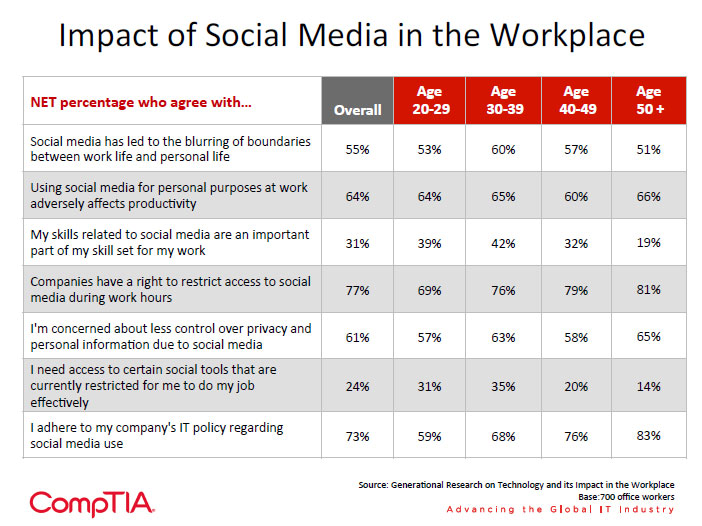
Younger workers have grown up in an era where flexibility is the norm and this is reflected in their thinking that companies that do not offer a telecommuting option are old-fashioned. Companies that offer this option are more attractive to 20- and 30-something employees. Gen Y value flexibility and want to work for companies that offer the option to telecommute and will even consider a lower salary if that benefit is provided.
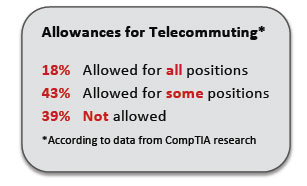 The majority of employees across age groups agree that they get more done when they work without office distractions. Staff in a senior role were more likely to agree
with this sentiment 62% agreed that telecommuting allowed them to get more work done when compared to 51% of middle or staff level employees. Employees in mid-size companies also felt that they got more done at home when compared to those in small
or large organizations.
The majority of employees across age groups agree that they get more done when they work without office distractions. Staff in a senior role were more likely to agree
with this sentiment 62% agreed that telecommuting allowed them to get more work done when compared to 51% of middle or staff level employees. Employees in mid-size companies also felt that they got more done at home when compared to those in small
or large organizations.
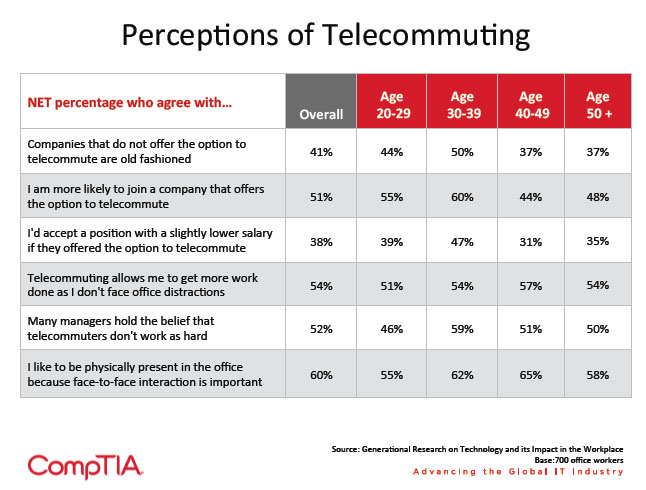
While the telecommuting and flexible work schedule trend shows few signs of slowing, it must be noted that the majority of employees in all age groups in CompTIA's research valued the connection, creativity and results that face-to-face interaction and collaboration produced. This is also reflected in the ideal working arrangement— only 10% of employees wanted a situation where they did not come into the office at all and 39% did not want any telecommuting days. The majority want an arrangement that features some days in the office and some from home. The balance in this arrangement is towards more days in the office. Forty-nine percent of respondents prefer to work in the office three or four days a week. CompTIA data also finds that telecommuting preferences are nearly identical between men and women.

Read more about IT Workforce.
Tags : IT Workforce